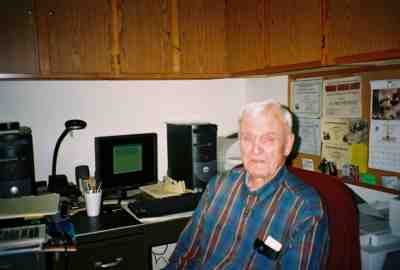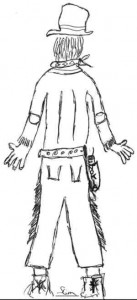Article by Marcia Darnell
Ralph Curtis – September 2005 – Colorado Central Magazine
Ralph Curtis has seen 25 years of water wars. Unlike most grizzled veterans, however, he’s survived with honor — esteemed, respected, and liked by those around him.As head of the Rio Grande Water Conservation District, he has witnessed dramatic changes in demographics, farming practices, land use, water use and water supply in the San Luis Valley. On the verge of retirement, he looks back on a good life’s work.
“I’ve learned the world of water is very complicated,” he says. “It’s the lifeblood of the West.”

He’s seen many changes, from subirrigation to leveling fields, “from siphon tubes to center pivots.”
“Some of what was done 100 years ago is still done today,” he says, “like wild flooding, which is still practiced in Conejos Canyon and the Alamosa River corridor, and along Saguache Creek.”
Wild flooding means turning on the water and just letting it flow. That kind of hands-off management is what led to the creation of the District.
The RGWCD was born of a lawsuit filed in 1966, when Texas and New Mexico sued Colorado for its unpaid water debt under the Rio Grand Compact, which requires Colorado to deliver specified amounts of water to those downstream states.
“That was going to be fought before the United States Supreme Court,” Curtis remembers.Legislation to form the district was passed in 1967. Progress was made to pay the water debt until 1985, when Elephant Butte Reservoir in New Mexico spilled, meaning the debt was canceled according to the Compact.
The District remained, with the purpose of maintaining the Rio Grande Compact obligations and mitigating ecological damage.
“The District is composed of five of the six counties in the Valley,” Curtis said. “We have a regional overview of the water situation in the Valley.” Costilla County elected not to join.
CHANGES IN THE LAST 30 years include the number of farms, a big increase since Curtis was a kid working with his father on their cattle ranch.
“There have been a lot of farming practices changed, too,” he says, “as far as trying to cut down on wind erosion.Now people ‘stubble mulch.’ That wasn’t even thought of 30 years ago.”
Stubble mulching leaves straw on the ground after harvest until the next growing season, cutting down on soil loss.There is also much more alfalfa being grown, using more water.
Curtis grew up in the San Luis Valley, in the Saguache area.He attended the University of Colorado at Boulder, earning a degree in business administration. He served two years in the Army, then returned to the family ranch, which he worked until it was sold in 1975.
He’s married to Gloria “Glo” Curtis, a Denver native, whom he met in college.
“She had culture shock when she came here,” he says. The couple have a grown daughter in Texas, a son in Denver, and several grandchildren.
In 1976 Curtis saw the U.S. Geological Survey set up a monitoring system for the unconfined aquifer, measuring water levels once a month. In 1983, the same system was established for the confined aquifer.This has provided good data for dealing with the current drought, making the groundwater model better. It also helped with the biggest war the District and the Valley fought: AWDI.
The Rio Grande Water Conservation District took the lead on battling American Water Development Inc., which in the early ’90s sought to export large quantities of water from the Valley, which would have effectively killed agriculture in this agriculturally-based com munity.
THE VALLEY TAXED ITSELF to finance the legal war, which continued on to the Supreme Court,and a victory for the farmers.
“Starting in 1995, we got the state to take native vegetative transportation and evaporation into account for its groundwater model,” Curtis recalls.”That has had a big impact on surface water rights.”
But there’s always a new water battle brewing.
“Society is demanding that there be more uses for water than traditional municipal, agricultural, and industrial uses,” Curtis says. “People want recreational uses such as kayak courses, but they want more conservation too.”
Fortunately, conservation efforts are growing.
“There are more river restoration projects,” he notes, especially natural ones. Restoration began in the mid-1980s, and “the last eight or 10 years we’re getting problems corrected.”
Recently, Curtis has focused on overseeing the division of the District into subdistricts, and finding resourceful ways water users can cope with a potential permanent water shortage.
“We’re doing the yeoman’s work,” he says.
“We try to treat it as a community project, where everybody is treated the same.” The subdistricts will provide more oversight of water use, and levy a charge based on water used — the less water someone uses, the less he pays.
“Voluntary cutbacks don’t work,” he says.
The large snowpack last winter made users think they could pump a lot, but the Rio Grande Compact sucked up a lot of the excess.Under subdistricts, if cutbacks are needed, everyone will cut back. The District is gathering signatures on petitions for the subdistricts. The progress is slow, but steady. “North of the river, we need owners of 102,000 acres to sign,” Curtis notes.”Right now we have 97,700. We have 48 percent of the 51 percent we need.” There’s no time deadline, however, and Curtis is confident of success.
“One of the things we’re also doing now is taking the lead on getting a Southwestern Willow Flycatcher conservation plan,” he says.”We don’t build projects, what we’re trying to do is prevent critical habitat designation.”
SEVERAL ENVIRONMENTAL organizations sued the U.S. Fish & Wildlife Service for designation of the bird’s habitat. A plan for that habitat must be done by the end of September.
“With the Valley being as flat as it is,” he speculates, “if we got critical habitat designation, and if a farmer or rancher wants to go out and remove some willows or trees, they’d have to consult with the Fish & Wildlife Service, which could be a real drag. We’re going after a permit that would designate the whole valley as habitat and take the burden off individuals. We may have to change some management practices, clean ditches and canals every three years, instead of every 10 to 15 years, but we’ll preserve that habitat and make healthier waterways.”
According to those who know him, that’s what Curtis does; he looks out for individuals and the Valley as a whole.
“I’ve worked with him extensively over the last five years,” says Mike Gibson, manager of the San Luis Valley Water Conservancy District and head of the Rio Grande Headwaters Restoration Project. “He’s a man very knowledgeable about water issues, has a deep interest in the future viability of the San Luis Valley, from a ranching/farming water perspective. He’s always been a pleasant individual to work with and always willing to share his expertise. He’s going to be missed by a lot of people in the Valley associatedwith water issues. We can only hope he’ll be available for consultation.”
Chris Canaly, head of the San Luis Valley EcoSystem Council agrees. “I’ve worked closely with Ralph over the last 15 years” she says. “From the time of AWDI and Gary Boyce. I love him and think he’s a great man. He provided so much consistency and continuity, and made time for people like me — to teach me, and help me. When we decided to start a land trust I approached him about being on our board, because of his credibility.
He’s still on that board. He saw the value in trying to preserve ag land through conservation easements.He’s a walking history book.”
Landowner Catherine McNeil appreciates Curtis, too. “Ralph is an absolute prince,” she says. “He’s got an incredible knowledge and history and ethic. The years he’s put in with the district have benefitted the water users and the Valley tremendously. He’s one of a kind.”
“He was initially in our wetlands meetings, and he really became helpful,” recalls Bob Sanders of Ducks Unlimited. “He became one of our strongest allies. Ralph has played a big part with work and advice. He’s great. A real sweetheart of a guy. A father figure to a lot of people in the San Luis Valley.”
CURTIS SAYS HIS GREATEST CHALLENGE has been “trying to explain to people who don’t understand Colorado water law why they can’t do what they want to do.”
The efforts toward that diplomacy has led to what he says is his greatest legacy, “fostering cooperation.”
Curtis plans to stay on at the District for a few months, to ease new director Steve Vandiver into the position.Then he and Glo plan to travel and spend time with their children and grandchildren.
Ralph Curtis has been looking out for individuals and the valley for a quarter of a century.And those who have worked with him agree: he’ll be missed.
Marcia Darnell lives and writes in the San Luis Valley. Her ag water use is limited to growing tiger lilies on the west side of her house.


